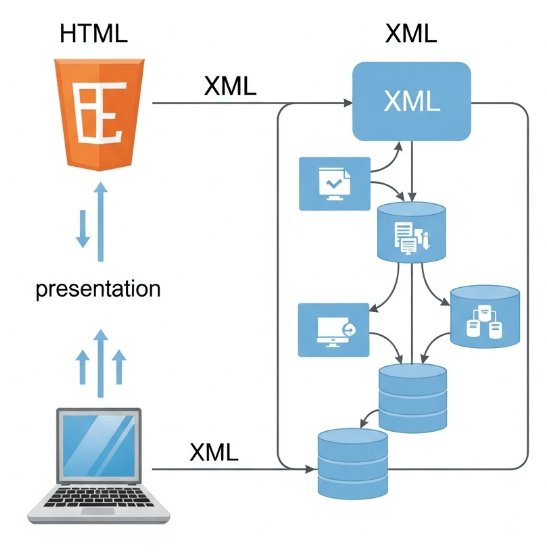Introduction to XML: Your First Deep Dive into Data Power
Welcome back! In our last chat, we got a glimpse of XML as the universal language for data. Now, let’s take a proper deep dive and truly understand what XML (eXtensible Markup Language) is all about, why it’s so important, and how it differs from other languages you might know.
What Exactly is XML? Breaking it Down
At its heart, XML is a markup language. This means it uses “tags” to define elements within a document. However, it’s very different from something like HTML. HTML uses predefined tags (like <p> for paragraph, <img> for image) to tell a browser how to display content. XML, on the other hand, is all about carrying and describing data, not displaying it.
Think of it this way: XML is designed to be self-descriptive. The tags themselves give meaning to the data. For instance, if you see <student_name>Rohan Singh</student_name>, you instantly know that “Rohan Singh” represents a student’s name. This makes XML data very easy for both humans to read and for computer programs to understand and process.
Furthermore, the “eXtensible” part in XML is incredibly powerful. Unlike HTML, where tags are fixed, XML allows you to define your own tags. You can create an unlimited set of tags tailored precisely to your data’s needs. This flexibility is what makes XML so versatile and widely used across different industries and applications.
The World Wide Web Consortium (W3C), a leading international community, developed XML. It officially became a W3C Recommendation in 1998, ensuring its widespread adoption and consistency across the globe.
Why is XML So Important? The Core Goals
XML wasn’t just created out of thin air; it was designed to solve real-world problems in data management and exchange. Its primary goals include:
- Simplifying Data Sharing: Different computer systems often use different data formats. XML acts as a common, neutral format, making it effortless for diverse systems to exchange data reliably. For example, a banking system built on one platform can send transaction data to an analytics system on another, all thanks to XML.
- Facilitating Data Transport: When data needs to move from one application or server to another, having it in a structured, self-descriptive format like XML streamlines the entire process. This reduces errors and ensures data integrity during transit.
- Increasing Data Availability and Reusability: By separating the data itself from how it’s presented (its style), XML makes data more accessible. Consequently, the same XML data can be used for various purposes – displayed on a website, used in a mobile app, or processed by a backend system – without needing to be reformatted.
- Platform and Language Independence: This is a monumental advantage! An XML document created by a program written in Java can be easily read and processed by a program written in Python, C#, or even a different operating system. XML breaks down barriers between technologies.
- Enabling the Creation of New Languages: XML is a “meta-language.” This means it provides the rules for creating other markup languages. For instance, you can design new industry-specific data formats based on XML, ensuring they are well-formed and structured.
XML vs. HTML: Understanding the Difference
Many beginners often confuse XML with HTML. While both use tags, their purposes are fundamentally different:
| Feature | HTML (HyperText Markup Language) | XML (eXtensible Markup Language) |
|---|---|---|
| Primary Purpose | To display data and design the layout of web pages. | To carry and describe data, focusing on its meaning. |
| Tags | Predefined tags (e.g., <h1>, <p>, <img>). You cannot create new ones. | User-defined tags. You invent and define your own tags as needed. |
| Case Sensitivity | Mostly not case-sensitive (<P> is usually treated like <p>). | Strictly case-sensitive. <Book> is different from <book>. |
| Closing Tags | Optional for some tags (e.g., <p>). | Mandatory. Every opening tag must have a closing tag (<tag>...</tag>). |
| Whitespace | Generally ignores extra whitespace between elements. | Preserves whitespace. Spaces and line breaks within content are kept. |
| Error Handling | Browsers are lenient; they try to “fix” poorly written HTML. | Strict. Even a small syntax error will stop an XML parser from processing the document. |
 In summary, HTML is about presenting information for humans to see in a web browser. On the other hand, XML is about defining and structuring data for machines to process. Understanding this core difference is key to appreciating XML’s power.
In summary, HTML is about presenting information for humans to see in a web browser. On the other hand, XML is about defining and structuring data for machines to process. Understanding this core difference is key to appreciating XML’s power.
What Does “Well-Formed” XML Mean?
A critical concept in XML is “well-formedness.” An XML document is considered well-formed if it follows all the fundamental XML syntax rules. These rules ensure that the document has a clear, unambiguous structure that any XML parser can understand. If an XML document is not well-formed, an XML parser will simply refuse to process it. This strictness is a core principle of XML, ensuring reliability in data exchange.
